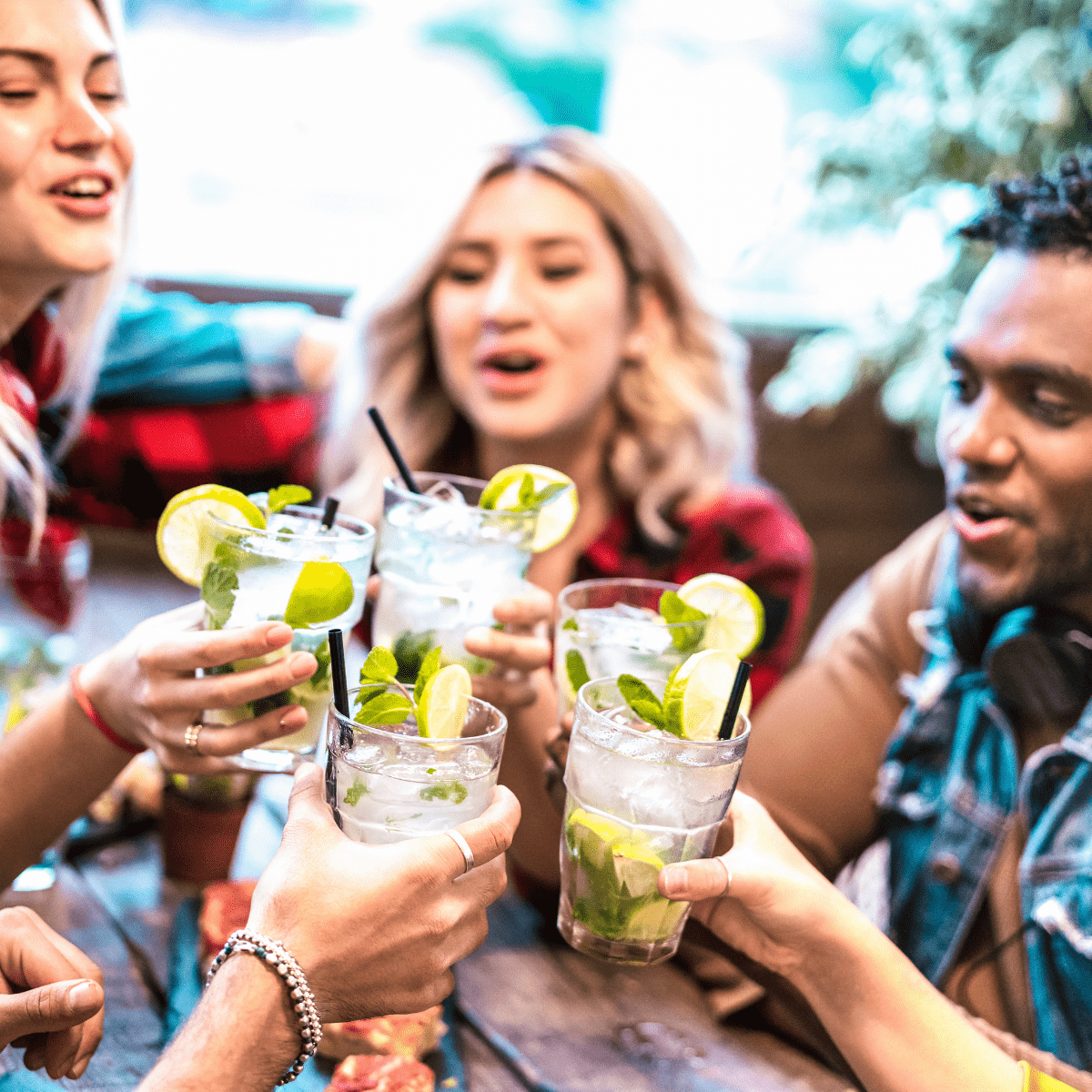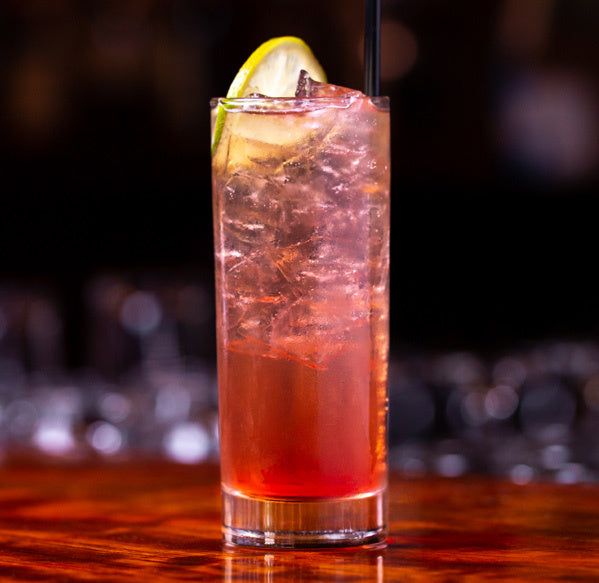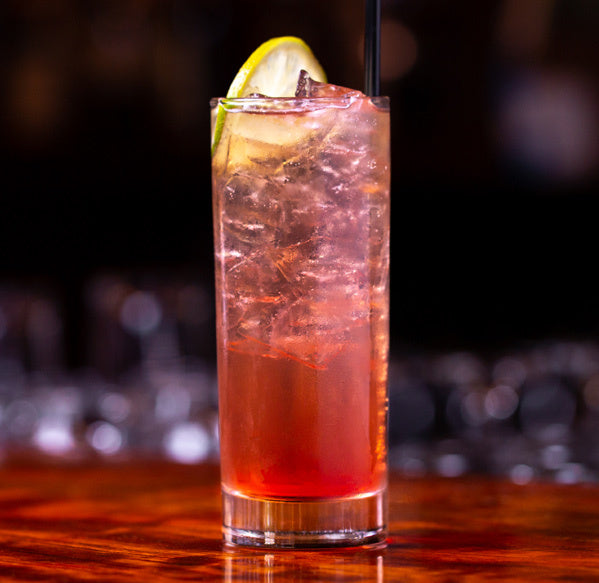Nearly everything you’ve heard about this cocktail syrup is probably wrong.
First, a truth: Grenadine is a brilliant red syrup used in cocktails to provide color and sweetness.
A misconception: It’s “just” for color and sweetness.
While grenadine does give both qualities to cocktails it’s used in, real grenadine — grenadine made according to the classic recipes — has much more to offer.
The trouble with grenadine, though, is that fakery, shortcuts, and general BS around products labeled “grenadine” have existed almost as long as the real deal. And they’ve managed to tarnish the rep of a perfectly fabulous cocktail syrup. (That’s the sort of thing we just won’t stand for around here.)
Real grenadine brings a lot more to the table (or bar) than just sugar and color. Made properly, it’s an ingredient worth actually building cocktails around.
What Is Grenadine, Exactly?
Recipes vary but in its most basic form, grenadine is a syrup made from pomegranate juice, sugar, and lemon juice. Other ingredients might be added — pomegranate molasses and orange blossom water being two of the main ones — but pomegranate juice, sugar, and lemon juice are all a syrup really needs to qualify as actual grenadine.
As for the name: “Grenadine” derives from the French word for pomegranate, “grenade” — not from the Grenadines archipelago, the island nation of Grenada, or the Spanish city of Granada. This syrup is all about a specific ingredient: pomegranates.
That all sounds straightforward enough, but fake grenadine has been around almost as long as the real deal. Like so many other corners of cocktail history, it’s a weird little story.
A Brief History of Grenadine
Fruity syrups have been part of the bartender’s toolkit since the very first cocktail recipes began to be published in the mid-1800s.
In his 1862 “How to Mix Drinks” and 1876 “Bartender’s Guide,” Jerry Thomas offers tips for storing and using raspberry and strawberry syrups. In 1891 grenadine made its first in-print appearance in William “Cocktail” Boothby's “American Bar-Tender,” where it was used in a sherbet. His 1908 edition featured grenadine in the Jack Rose [https://proofsyrup.com/blogs/recipes/jack-rose] and Opalescent, aka Clover Club [https://proofsyrup.com/blogs/news/clover-club]. Grenadine in cocktails: officially A Thing.
Over the next 30 years grenadine began to seep into more and more American cocktail recipes. By the time the Savoy Cocktail Book was published in 1930, dozens of cocktails called for it. But from early on, grenadine was often presented as a substitute for raspberry or strawberry syrups, leading many even today to think of grenadine as flavored by berries rather than pomegranate.
The confusion about what grenadine is, or is supposed to be, is worse than that, though. That “just for color” slander? There’s a certain logic to it, and it has to do with the early and frequent proliferation of fake grenadines.
Back in 1872 — before grenadine had even taken off as a cocktail ingredient in the United States — a manufacturer of real, pomegranate-based grenadine sued the maker of “grenade syrup” over his use of a grenadine-esque name.
This tells us two things: (1) at least one guy, bless him, was making real pomegranate-based grenadine in the United States as of 1872, and (2) at least one other guy was making a fake version at the same time. While the New York State Supreme Court appears to have agreed that the use of “grenade” was deliberately deceptive, the chicanery only continued.
A 1906 manual on soda and beverages for the drug store and confectionery industries published a pomegranate-free grenadine recipe that relied on ground beetles for its red color.
In 1912, according to the delightfully geeky alcademics.com, a ruling came down in a case called U.S. vs. Thirty Cases Purporting to be Grenadine Syrup. Thirty cases is a lot of fake grenadine — enough to grab the attention of the U.S. government, which seized it because it contained nary a drop of pomegranate. And how’d the court rule in this case? Against grenadine. Because Americans at the time had insufficient knowledge of grenadine to have any expectation as to its ingredients, the court reasoned, it was A-OK to sell fake grenadine.
It didn’t take long for bartenders to catch on to all this fakery — and from there, a backlash against even the idea of grenadine took hold. American grenadine was held in especially low regard, and bartending manuals began advising against its use. It was in the 1930s and 1940s that the idea of grenadine as a coloring agent — but nothing else — gained acceptance, and it hung on.
One can hardly blame bartenders, on anybody, for concluding that grenadine had no value in cocktails beyond adding color. The bummer of all this is that their lack of interest in the real thing meant that cocktail recipes incorporating grenadine in a central way are relatively few and far between. There are lots of recipes calling for a single barspoon of grenadine, but not nearly enough that take advantage of the unique flavor it provides.
It also can’t have helped that the most popular and widely available grenadine in the U.S. marketplace, Rose’s, is made from high fructose corn syrup, citric acid, preservatives, and red and blue food coloring.
True grenadines remain hard to find. Rose’s utter domination of the market doesn’t help, but ultimately the problem lies with lack of consumer interest in authentic grenadines — which will necessarily cost more than the fakes that retail for something on the order of four bucks per liter. Turns out a century of bad reputation is a tall order for any lil’ syrup to overcome. Which is a pity, because real grenadine is delicious.
How & When To Use Grenadine In A Cocktail
If you want to give grenadine a chance, we applaud your willingness to buck conventional wisdom and 100 years of beverage history in the pursuit of delicious cocktails. You rock!
But to fully appreciate any cocktail ingredient, you need to know where to use it. Here are some grenadine mixing notes, followed in the next section by a slew of grenadine recipes we love:
Gin, with its botanical and herbal flavors, is a natural fit for fruity, slightly floral grenadine. If you’ve never had a Clover Club — gin, lemon juice, raspberry syrup, and egg white — rectify that at the next opportunity. If a Clover Club sounds tasty to you, try our Clover Club-style gin sour.
Rum’s sweetness and molasses funk play nicely with grenadine’s fruitiness in cocktails like the Mary Pickford and rum runner.
Vodka lets that tart-sweet pomegranate juiciness shine. A cosmo made with real grenadine is to die for, and a vodka soda with up to a full ounce of grenadine and a quick squeeze of lime is pure sparkling deliciousness.
Tequila and mezcal make delicious grenadine-tinged margaritas — and then there's the incredible Mexican Firing Squad, a grenadine-tequila-bitters cocktail. And thanks to the tart, tangy pomegranate, grenadine has enough flavor to stand up to the earthy, vegetal flavors of agave spirits.
Grenadine also mixes well with whiskey, particularly in rye and bourbon cocktails like the Ward Eight, the Scofflaw, the bourbon daisy, and the quirky, grapefruit-based Blinker. In these recipes, the whiskey and citrus mix well with the pomegranate, giving these cocktails a nicely balanced sweet-tangy flavor similar to a more spirit-forward whiskey sour.
Are There Substitutes for Grenadine?
Grenadine is often used interchangeably with raspberry, cherry, and strawberry syrups — you’ll even see this in many cocktail recipes — but each of those is very much its own thing, with a distinctive flavor profile and uses. If you want to make a cocktail that calls for grenadine, get you some real, authentically made grenadine, the best you can find.
If you were the kind of kid who made an A+ on every test but did the extra credit assignment anyway, go right ahead and make your own grenadine. Even the most cursory google search will turn up dozens of DIY recipes.
Fair warning, though: Most of those recipes are designed to be stupid-simple, and they call for just pomegranate juice, lemon juice, and sugar — all of which are indeed used in traditional grenadines, but if you go that route you’ll lose the richness and nuance supplied by pomegranate molasses and orange blossom water. Look for a recipe that calls for those slightly harder-to-come-by ingredients, and you might end up with a decent substitute for authentically made grenadine.
Our Favorite Grenadine Cocktails
The Daisy
The gin version of this classic is the most well-known, but the daisy is in practice more of a template than a single cocktail. It’s a recipe that embraces just about anything you want to mix into it. We recommend gin, bourbon, applejack (or apple brandy), and rum, but we’ve enjoyed fantastic daisies made with vodka, flavored bourbons, moonshine, and even tequila. Pro tip: You can do up a daisy tall, with ice and club soda, or short, by skipping the ice and soda and just straining the cocktail into a coupe. Delicious either way! | Classic Daisy Recipe
Mexican Firing Squad
This crazy-good cocktail is another two-fer: a short, strong, margarita-style sour that converts to a tall, refreshing sipper by the addition of club soda. Either way it’s beautifully balanced, complex, and delicious. Made with tequila, lime juice, grenadine, and bitters, it’s also a bonafide classic that entered American cocktail culture via a travel writer who first tried it at La Cucaracha Bar in Mexico City in the 1930s. (And yes, that was the name La Cucaracha gave it.) | Mexican Firing Squad Recipe
Jack Rose
Invented around the turn of the 20th century, the Jack Rose is made with applejack, often said to be America’s first spirit. (It predates bourbon by a few years.) This simple combination of applejack, lemon juice, and grenadine yields a cocktail that’s rosy in color and tart and apple-y in flavor. (And for what it’s worth: applejack and apple brandy are legally two different things, but in cocktails they’re effectively the same.) | Jack Rose Recipe
Clover Club-Style Gin Sour
The Clover Club cocktail dates back to the 1800s, at the Bellevue-Stratford Hotel in Philadelphia — apparently a popular hangout in its day, the kind of place where fancy folk who knew a tasty cocktail when they sipped one liked to talk shop. The original recipe called for raspberry syrup, but given the frequent syrup swapping among raspberry, other-berry, and pomegranate syrups across the span of cocktail history, we tried dropping some of our Classic Grenadine in a Clover Club. And wow — the resulting cocktail was delicious, especially when made with the optional-but-recommended egg white. Garnish as the spirit moves you — the textbook recommendation is a fresh raspberry, but a Luxardo cherry will do in this reinterpretation. | Clover Club-Style Gin Sour Recipe
Scofflaw
This Prohibition-era cocktail gets its name from a 1924 contest that sought to invent a name for lawless drinkers, “to stab awake the conscience.” A bartender at Harry’s Bar in Paris thought the winning word — scofflaw — sounded like a fun name for a cocktail. This sour-like cocktail is made from either bourbon or rye whiskey, dry vermouth, lemon juice, grenadine, and orange bitters. | Scofflaw Recipe
Further Reading
A Selection of Grenadine Cocktails








